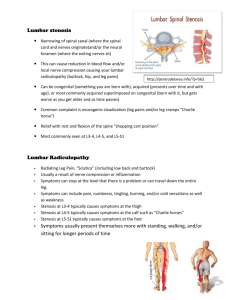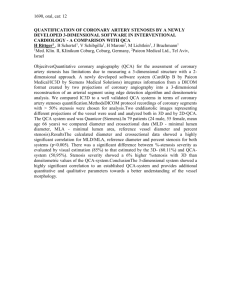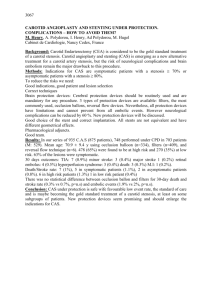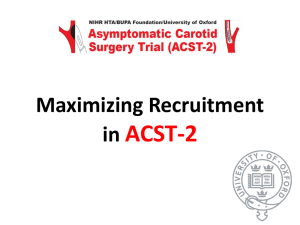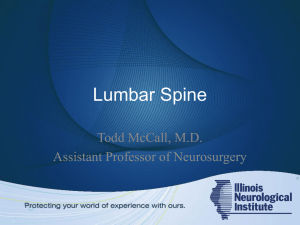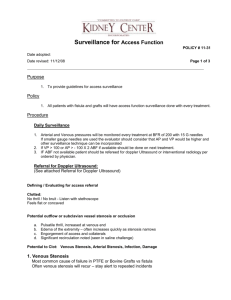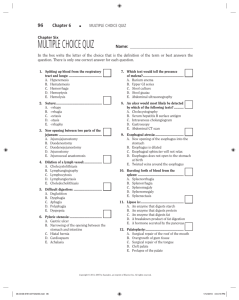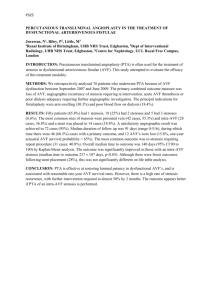LARYNGOTRACHEAL STENOSIS
advertisement
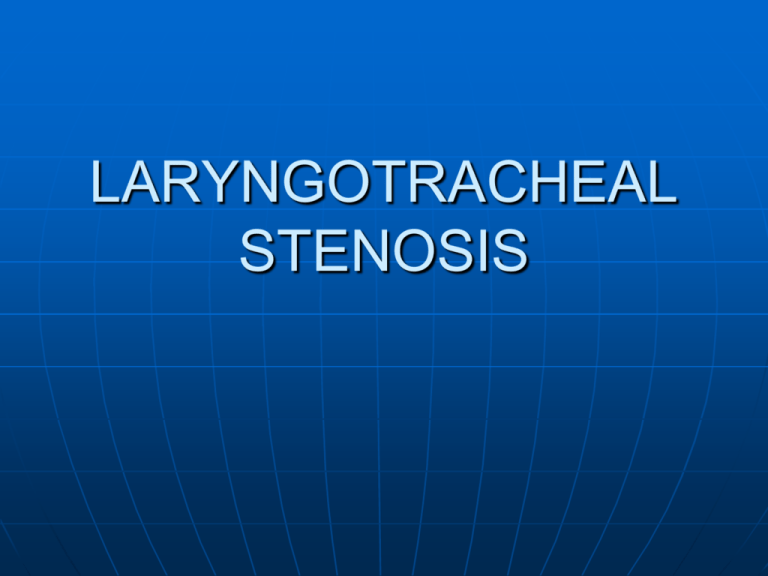
LARYNGOTRACHEAL STENOSIS INTRODUCTION LTS is a perplexing problem to treat . Treatment options depend upon site, nature of injury , its effect on laryngeal function. Though surgeon is provided with so many treatment options proper case selection ,timing of procedure decides the final outcome. Successful repair requires establishment of adequate airway while preserving laryngeal functions such as airway protection, phonation, sustained glottic closure to raise intra thoracic pressure. ETIOLOGY 1.Trauma: External • blunt • penetrating Internal • • • • • intubation post tracheostomy post surgery post radiotherapy thermal/ chemical burns ETIOLOGY 2. Chronic inflammatory disease • • • • • • tuberculosis/ leprosy sacoidosis scleroma histoplasmosis diphtheria syphilis 3. Benign disorders • intrinsic papilloma/chondroma minor salivary gland / nerve sheath tumor • extrinsic Thyroid/ thymic tumors ETIOLOGY 4. Malignant disorders • Intrinsic SCC/ minor salivary gland tumor sarcoma/ lymphomas • Extrinsic Thyroid malignancy 5. Collagen vascular disorders • Wegeners granulomatosis • Relapsing poly chondritis PATHOPHYSIOLOGY Knowledge of pathophysiologyy is essential that it gives idea regarding time/ frequency of intervention, surgical procedure required and its outcome. Endotracheal intubartion • ischemic necrosis ( pressure ) • mucosal ulcer+ inflammation = fibrosis others: duration, composition/ size of tube, laryngeal movement. primary site ; post glottis. PATHOPHYSIOLOGY External trauma disruption of cartilagenous framework hematoma/ mucosal disruption hematoma: • cartilage loss • heals by fibrosis • secondary infection OTHERS: • DM, CCF, stroke, GERD. • idiopathic- females (estrogen- TGFβ ). CLASSIFICATION COTTONS system of grading GRADE % OF STENOSIS Grade 1 <50 % Grade 2 Grade 3 Grade 4 50- 70 % 71- 99 % (minimal lumen) complete obstruction CLASSIFICATION Post glottic stenosis (bogdasarin & olson) TYPE 1 vocal process adhesion TYPE 2 post commissure stenosis with interarytenoid plane scarring. TYPE 3 post commissure stenosis with ankylosis of unilat crico arytenoid joint TYPE 4 post commissure stenosis with bilateral cricoarytenoid joint ankylosis. CLASSIFICATION Mc Caffery ( clinical status ) GRADE 1-subglottic / tracheal stenosis <1cm long. GRADE 2- subglottic stenosis <1 cm within cricoid ring without glottic / tracheal extension. GRADE 3-subglottic leison with extn upto upper trachea but no glottic involvement. GRADE 4-glottic involvement with fixation/ paralysis of one/ both vocal folds. ASSESSMENT OF LTS History : trauma, mode of onset, effect on airway, voice etc… Indirect/ Direct laryngoscopy, Bronchoscopy, PFT HRCT with 3-D reconstruction, virtual endoscopy Timing of repair: granlomatous/autoimmune disorders require stabilisation of underlying disease process . REPAIR REQUIREMENTS First requirement is an intact and reasonably shaped framework to provide a scaffold. acute / blunt injury: cartilage #/ distracted. Better managed by open reduction and stabilisation. chronic injury : cartilage absent / chondromalacia/ necrosis. It requires cartilage/ bone grafting REPAIR REQUIREMENTS LTS repair can be achieved using , ideal mesodermal graft skin/ mucosal graft stents mitomycin –C topical application powered instrumentation LASER REPAIR REQUIREMENTS MESODERMAL GRAFT; An ideal graft , rapid healing with minimal long term graft resorption (vascularised graft ) adequate strength, size, pliability to be contoured to the defect. minimal donor site morbidity. presence of accompanying epithelial lining single stage reconstruction. donor site within same operative field grafts ; rib cartilage, iliac crest, septal / conchal cartilage, hyoid / thyroid cartilage. REPAIR REQUIREMENTS SKIN/ MUCOSAL GRAFTS ; Second main requirement for a successful repair is establishment of epithelialised lumen. Acute injury ; primary closure . Chronic; • scar excision- epidermal/ mucosal graft • Small defect – heal by secondary intention REPAIR REQUIREMENTS STENTS ; Egs; montgomery, silicon keel, aboulker stent, swiss roll siliconised rubber roll stent, finger cot stent. Indications ; To provide support for cartilage/bone grafts or to splint displaced cartilage fragment in desired position. Approximation of epidermal graft to recipient site. Two opposing raw surface during healing . maintain lumen in a reconstructed area that lacks adequate cartilage support and scar formation. REPAIR REQUIREMENTS TRACHEAL STENTS; ballon expandable • palmaz • strecker Self expanding metallic • giantyrw, wallstent • nitinol/ ultraflex silicone stent • montgomery • dumon stent bio absorbable REPAIR REQUIREMENTS MITOMYCIN- C (topical ) anti neoplastic antibiotic. alkylating agent, inhibits DNA/ protein synthesis. reduces collagen formation in sub glottic scar. REPAIR REQUIREMENTS POWERED INSTRUMENTATION; Micro debrider removes granulation respiratory papilloma removal. Advantages; • less injury to adjacent tissue • reduces surgery time Contra indication; vascular leision. REPAIR REQUIREMENTS LASER ; Delayed formation of collagen – allows time for epithelialisation . Minimal deep tissue injury. Precise control/ Hemostasis. Disadvantages ; Risk of airway fire. Thermal burns. LASER plume – infection/ harm to surgeon and OT staff. SURGICAL MANAGEMENT SUPRA GLOTTIC STENOSIS ; injury can be • epiglottis adherent to post / lateral hypopharyngeal wall. • hyoid # - displaced posteriorly with epiglottis = inlet stenosis. • horizontal web of post hypo pharyngeal wall at level of superior aspect of epiglottis. Approach; trans hyoid pharyngotomy. Supra glottic stenosis treatment trans hyoid pharyngotomy; horizontal skin incision( hyoid bone ) if hyoid # ( reduced& fixed, removed ) vallecula entered. adhesion of epiglottis to post / lat wall • division along long axis. • sub mucosal excision of scar. • primary mucosal closure. horizontal web • vertical incision – scar excised. • mucosal flaps undermined- horizontal line closure Supra glottic stenosis treatment In case of extensive mucosal defect – skin graft. Full thickness loss – radial forearm flap. In case of post displacement of hyoid/ epiglttic cartilage, laryngofissure • base of epiglottis identified. • ant fascia, perichondrium ,& epiglottis incised inverted V shape. • Mucoperichondrium of epiglottis elevated superiorly. • Scar tissue ,base of epiglottis excised • Mucoperichondrium incised & flaps turned outward and sewn to ant epiglottis • Thyrotomy closed. Glottic stenosis Ant glottic stenosis; external trauma/ post intubation. • thyroid cartilage #/ mucosal disruption two opposing raw surfaces heals by fibrosis thin/ thick web – hoarseness/ airway compromise. successful repair requires physical seperation of opposing edge until epithelialization is complete. Glottic stenosis Ant glottic web ; MLS / CO2 laser excision – keel insertion keel inserted – endoscopically /mini cricho thyrotomy Ideal keel ; • stable, inert • extension- cricho thyriod membrane to 2-3 mm above ant commissure. • post wing at vocal process not in post commissure. • if extends above petiole, angle should be 120^. Glottic stenosis Ant glottic stenosis; external laryngo fissure indications; • sub glottic extension >5 mm • inlet stenosis. • failed endoscopy. scar excised preserving mucosa mucoal defect- labial mucosal/ skin graft with short term stenting with montgomery tube/ Mc Naught tantalum keel. Glottic stenosis Post glottic stenosis; cause – post intubation (most common) _ cricho arytenoid joint arthritis. repair • • • • • endoscopic excision of web. Co2 laser. laryngofissure- submucosal excision of scar endoscopic laser arytenoidectomy (type 4 ) Post crichoid split with rib cartilage grafting. Glottic stenosis complete glottic stenosis; laryngofissure ( main stay of treatment ) • Stenosis divided at midline. • scar excised preserving mucosa & developing mucosal flap from AEF. • If extensive area is devoid of mucosa- grafting (buccal mucosa, septal mucosa, SSG, ) is done. • Graft sutured in place and stent kept. • Stent removed at a later date. Glottic stenosis Alternative approach; Epiglottic flap indication • severe glottic stenosis with 50% reduction in A-P diameter of glottis. midline thyrotomy submucosal scar excision base of epiglottis identified. epiglottis pulled inferiorly to crichoid arch and sutured to thyroid (lat ) , crichoid (inferiorly ). Subglottic stenosis ENDOSCOPIC METHODS • Co2 laser • micro debrider. Co2 laser excision and repair with micro trap door flap – circumferrential sub glottic stenosis. Radial incision at 12, 3, 6, 9 O’ clock position – bronchoscopic dilatation. Subglottic stenosis EXTERNAL APPROACH; scar resection and SSG grafting. hyoid sterno hyoid muscle interposition graft . thyroid sterno thyroid pedicle graft. costal cartilage / septal cartilage grafting post crichoid lamina split & internal rigid stenting. partial cricoid resection with thyro tracheal anastomosis. • risk RLN injury. • need for laryngeal release. • neck kept in complete flextion in post – op. Cervical tracheal stenosis It is of three types; cicatrical membranous stenosis. ant wall collapse. complete tracheal stenosis. cicatrical membranous stenosis; Endoscopy; • Co2 laser excision. Open approach; mid line incision. • sub mucosal scar excision. • luminal augmentation –(thyroid cartilage sterno thyroid) • Epidermal grafting. Cervical tracheal stenosis Ant wall collapse; • supra stomal • stomal • infra stomal Repair; stenting with m- tube/ aboulker stent. stabilisation with sterno hyoid muscle pedicle over weak segment. Cervical tracheal stenosis Repair; wedge resection of ant tracheal wall; Indication • stenosis limited to 2-3 ring with cartilage loss. • post wall mucosa intact. • supra / stomal leision sub perichondrial dissection and wedge excision done. oro endotracheal tube kept. ends sutured back primariy. Cervical tracheal stenosis Complete tracheal stenosis; reasection and anastomosis (optimal treatment ) approximately 50 % of trachea can resected safely & anastomosed with appropriate mobilisation. Tracheal resection anastamosis; Indication ; subglottic/ tracheal- complete/ near complete stenosis. • ant crichoid arch/ post lamina resected just below crico arytenoid joint. • primary closure done extra luminally. • neck kept in extreme flextion. extensive LTS; multi staged trough reconstruction. LTS IN PEDIATRIC AGE GROUP ANATOMY; situated at a higher level funnel shape; midcricoid area 2-3 mm below cords narrowest. small and narrow lumen. mucosa has loose areolar tissue with abundant sub mucosal fluid. LTS IN PEDIATRIC AGE GROUP ETIOLOGY; congenital • • • • cong sub glottic stenosis vocal cord paralysis sub glottic hemangioma laryngomalacia/ tracheomalacia. acquired • inflammatory • neoplastic • traumatic LTS IN PEDIATRIC AGE GROUP MANAGEMENT; endoscopic open techniques • • • • ant cricoid split laryngo tracheoplasty laryngo tracheal reconstruction crico tracheal resection and anastomosis LTS IN PEDIATRIC AGE GROUP POST OP MANAGEMENT; antibiotic cover anti reflux medication 6 wk endoscopy- granulation removal stent removal 6-8 wks anastomotic complications; • granulations • stenosis • dehiscence RESTENOSIS PREVENTION; steroids,mitomycin-c anti reflux/ antibiotics tissue engineering techniques fetal fibroblasts transposition( IL6,8) tissue engineered scaffolds (hyaluronic acid/ caboxy methyl cellulose ) marlex mesh tube covered with collagen sponge. THANK YOU

